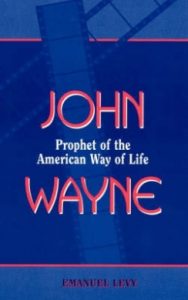Dark Command is one of the three pictures John Wayne made with Claire Trevor; the others were Stagecoach and Allegheney Rising, both in 1939. In all three, Trevor, then a bigger name than Wayne, got star billing.
| Dark Command | |
|---|---|

1940 film poster
|
|
Loosely based on Quantrill’s Raiders during the American Civil War, Dark Command is adapted from the novel by W. R. Burnett.
Republic, known as one of the Poverty Row studios, invested a bigger budget than the usual on this Civil War adventure, resulting in more polished production values (and two Oscar nominations).
The studio then hired old pro Raoul Walsh to direct and Victor Young to compose music for this period adventure, set in 1860 Kansas. They also borrowed from MGM one of its most accomplished actors, Walter Pidgeon, to play John Wayne’s rival.
Walsh knew the Duke back from the days when they made The Big Trail, a 1930 big-budget Western that was going to make the Duke a major star, but, unfortunately, failed at the box-office.
Note:
If you want to know more about John Wayne’s career and life, please read more my book:
Other familiar faces in the cast included Gabby (formerly known as George) Hayes, as Wayne’s sidekick, Harry Woods, Glenn Strange, and Al Bridge. Dark Command is the only film in which Wayne and Roy Rogers, then a B-cowboy actor soon to become a Western icon on his own right, appear together.
The first reel is rather amusing, depicting Wayne’s Bob Seton as the traveling companion of a dentist named Doc Grunch (Hayes). The division of labor between them is that Seton gets into fights, making sure that his blows send his opponents to the dentist’s chair.
Seton’s frivolous existence changes when he decides to improve on his lot, by taking reading and writing lessons, and setting his goal as no less than becoming a U.S. marshal.
Though ambitious, he remains nave and shares his career plans with Will Cantrell (Pidgeon), a schoolteacher considered to be the unopposed candidate for the desirable job.
Seton wins the elections and a resentful Cantrell becomes a gunrunner and then a leader of a guerrilla bunch that terrorizes the region; this is, after all, pre-Civil War America.
In most of his films, John Wayne doesn’t let women prevent him from accomplishing a task he is committed to, and this one is no exception. In Dark Command, marshal Seton is forced to arrest the kid brother Fletch (Roy Rogers) of the respected town lady Mary McCloud (Claire Trevor) kid brother and bring him to trial for murder. Mary is willing to give herself, if he releases her brother but he refuses.
Marry goes on to marry the schoolteacher Cantrell, not because she loves him, but because he is willing to defend her brother. Plot is full of twists and turns, with the marshal first captured by Cantrell, then escaping and vowing to avenge. At the end, after a shoot out with Cantrell, the marshal asks Mary to start a new life with him in Texas, just as the Ringo Kid asked Dallas (Claire Trevor) at the end of “Stagecoach.”
Cantrell’s character is reportedly a largely fictionalized version of the actual Charles Quantril. Some humor is inserted into the saga. When marshal Seton is told that a fellow by the name of Shakespeare once said, “All well than ends well,” he replies, “He must have come from Texas, we have been saying that for years.”
Oscar Alert
Oscar Nominations: 2
Interior Decoration (b/w): John Victor Mackay
Score (Original): Victor Young
Oscar Context
The winner of the Interior Decoration Oscar was “Pride and Prejudice,” and of the Original Score award went to “Pinocchio.”
Wayne and Raoul Walsh
Dark Command was the only film Wayne and Raoul Walsh made together since Walsh discovered Wayne working as a prop mover, renamed him, and gave him his first leading role in the widescreen western The Big Trail a decade before.
Synopsis (How the Plot Unfolds):
Mary McCloud (Trevor) marries a seemingly peaceful Kansas schoolteacher William Cantrell (Pidgeon), before finding out that he harbors a dark secret. He is actually an outlaw leader who attacks both sides in the Civil War for his own profit. After capturing a wagon loaded with Confederate uniforms, he decides to pass himself off as a Confederate officer. Her naive, idealistic brother Fletcher (Rogers) joins what he believes is a Rebel guerrilla force. Meanwhile, Cantrell’s stern, but loving mother (Marjorie Main) refuses to accept any of her son’s ill-gotten loot.
A former suitor of Mary’s, Union supporter Bob Seton (Wayne), is captured by Cantrell and scheduled for execution. After being rescued by a disillusioned Fletcher McCloud, Seton and Mary Cantrell race to the town of Lawrence (the site of the actual infamous Quantrill-led massacre) to warn the residents of an impending attack by Cantrell’s gang.
Cast
Claire Trevor as Mary McCloud
John Wayne as Bob Seton
Walter Pidgeon as William “Will” Cantrell
Roy Rogers as Fletcher “Fletch” McCloud
George “Gabby” Hayes as Andrew “Doc” Grunch
Porter Hall as Angus McCloud
Marjorie Main as Mrs. Cantrell, aka Mrs. Adams
Raymond Walburn as Judge Bucknell
Joe Sawyer as Bushropp
Helen MacKellar as Mrs. Hall
J. Farrell MacDonald as Dave
Trevor Bardette as Mr. Hale
Credits:
Directed by Raoul Walsh
Produced by Sol C. Siegel
Written by F. Hugh Herbert, Lionel Houser. Grover Jones, Jan Isbell Fortune (adaptation), based on the 1938 novel, “The Dark Command,” by W.R. Burnett
Music by Victor Young
Cinematography Jack A. Marta
Edited by William Morgan
Production and distribution: Republic Pictures
Release date: April 15, 1940
Running time: 94 minutes
Budget $750,000





